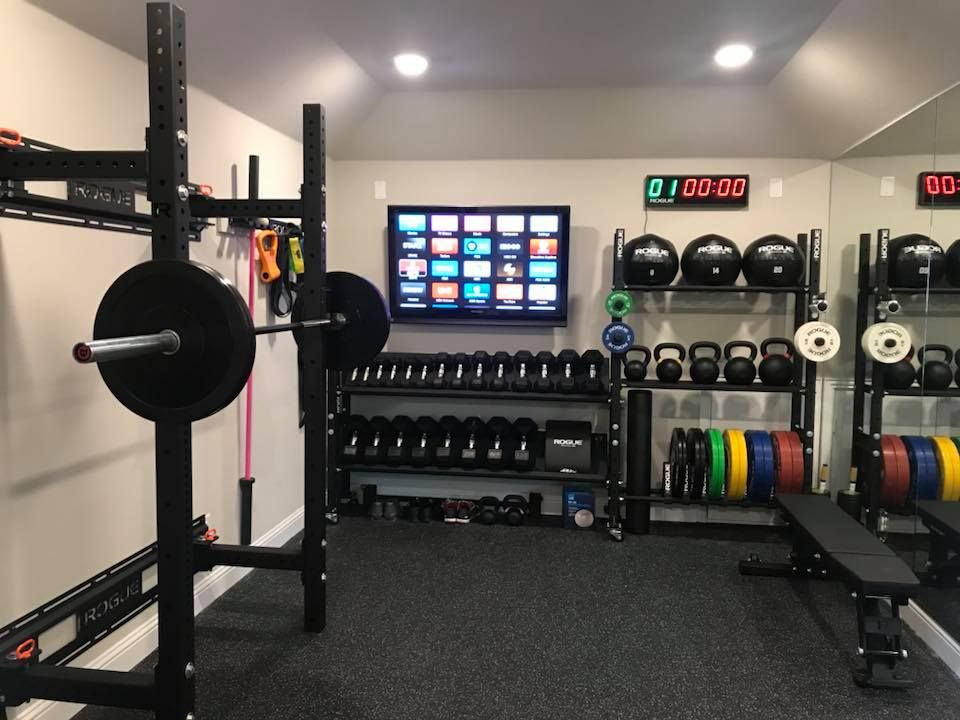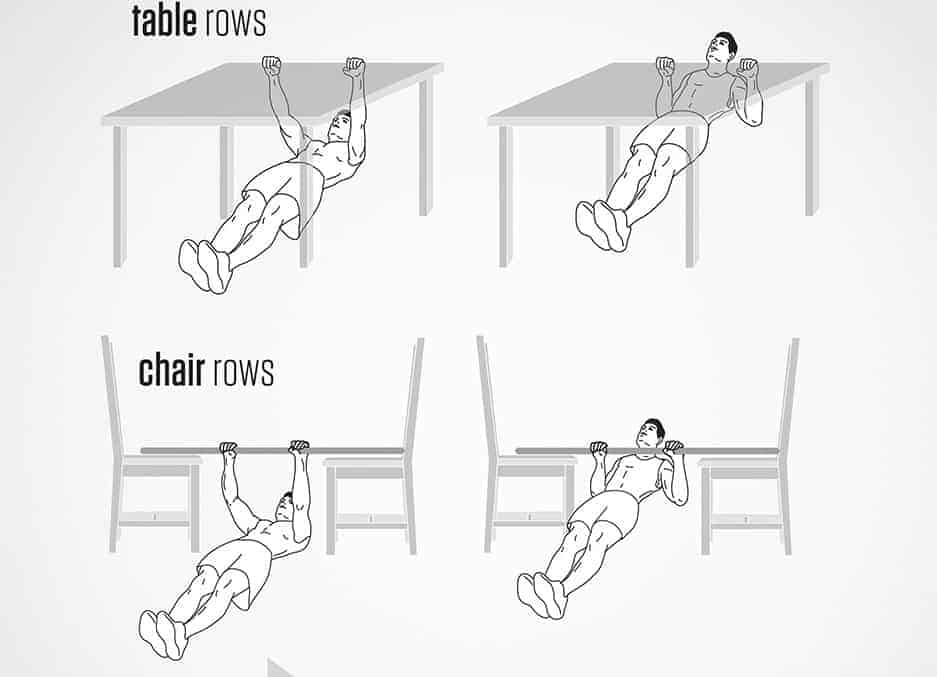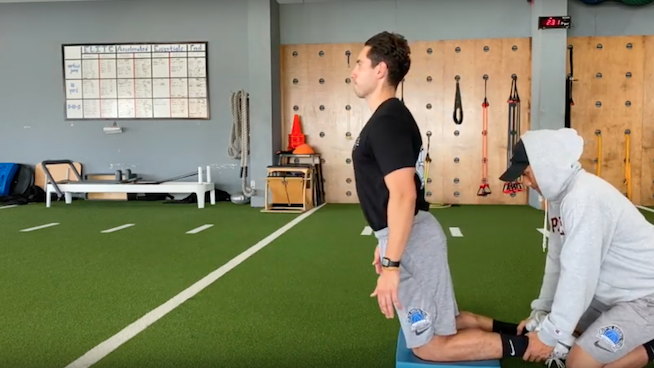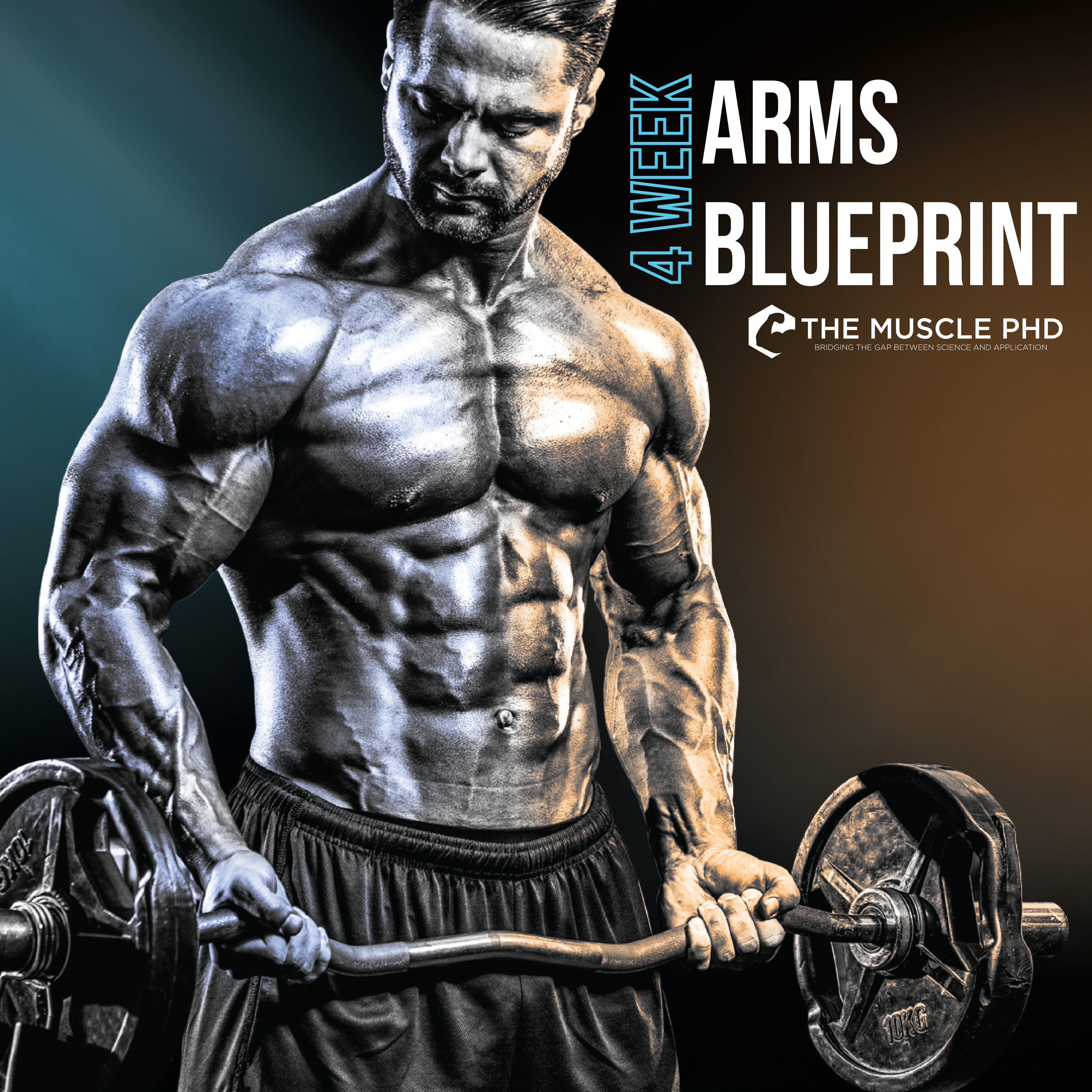Introduction
We typically don’t touch on bodyweight training much on this website because, frankly, it’s not the optimal training mode for gaining massive amounts of size and strength. However, due to current circumstances, many of us are stuck at home without much, if any, equipment. With the COVID-19 pandemic in mind, how can we go about training at home in order to maintain as much muscle as possible?
Home Gym: to Buy, or Not to Buy?
First off, assess your living situation. Do you have some extra space? Do you have extra money in savings or the ability to finance a few thousand dollars? If so, a home gym can be a great option for you. While this option isn’t realistic for many people, if you’re lucky enough to fall into one of the above categories, making the investment in a home gym can be a phenomenal decision for your long-term training outcomes. Gone are the missed gym days due to not wanting to leave the house. Forget the days where you had too much going on at home to hit the gym. Say goodbye to the majority of your excuses for skipping leg day.
 A home gym doesn’t have to be luxurious or insanely complicated. Keep it simple. A rack and bench, a good barbell, enough weight, and an adjustable pair of dumbbells will set most people up for a ton of success – especially if you get creative with exercise variations. For these items, I’d suggest going with a trusted manufacturer like Rogue or EliteFTS. They’re going to be pricier, but the payoff is that your equipment fits together properly, looks great, and will last through the next ice age. You could order some discount garbage off of Amazon and save some cash, but you also risk the rack snapping in half when you rack your barbell after a heavy squat set.
A home gym doesn’t have to be luxurious or insanely complicated. Keep it simple. A rack and bench, a good barbell, enough weight, and an adjustable pair of dumbbells will set most people up for a ton of success – especially if you get creative with exercise variations. For these items, I’d suggest going with a trusted manufacturer like Rogue or EliteFTS. They’re going to be pricier, but the payoff is that your equipment fits together properly, looks great, and will last through the next ice age. You could order some discount garbage off of Amazon and save some cash, but you also risk the rack snapping in half when you rack your barbell after a heavy squat set.
With the above suggestion (I’ve already priced it for my own garage), you’re looking at about $2-3000 depending on what rack, bench, and adjustable dumbbells you get. Most good power bars are around $250-300 and plate weights are pretty standard pricing if you just go with the tried-and-true iron plates. If you don’t want to dump a few thousand in one purchase, larger manufacturers (like Rogue and EliteFTS) offer financing through lenders on their websites but you might be able to get a better rate if you take out a small personal loan through your bank. You can also save a few bucks by going to manufacturer websites instead of other retailers. Almost everyone sells York plates, but the cheapest place to find [new] York plates is… you guessed it. The York website (here).
Lastly, if you plan on deadlifting or doing any floor-based exercises, I’d also suggest getting some rubber floor tiles. These can be ridiculously expensive on gym equipment websites but there’s a few tricks around that. If you just want rubber tiles for deadlifts, you can get packs of 3-6 at Lowe’s, Home Depot, etc. for pretty cheap – you can even check out rubber welcome mats for a cheaper option. If you want to outfit an entire garage/room (probably the safest choice), you can use horse stall mats for your cheapest option – you can find these at most larger hardware stores or even Tractor Supply Co. You’re looking at an additional $500-1000 for brand name rubber flooring but using horse stall mats could actually keep your floor budget in the $100-150 range (all depends on square footage).
Again, this option won’t work for everyone, and many are already seeing home gym equipment being sold out and having extensive shipping delays so now may not even be the best time to buy. But this is a great investment for multiple reasons – plus, you’ll be prepared for the next pandemic. If you don’t want to dip into savings too much, a decent band pack and weight vest can be had for less than $100 combined and offer plenty of utility for at home workouts. I spent about $75 on Amazon for both combined – I tagged the Amazon links if you hover over the “band pack” and “weight vest” words.
Upper Body Exercises
Okay, let’s assume you have virtually no equipment but you’re still trying to maintain as much size as possible. What exercises can you do for the upper body in the comfort of your own home?
Chest
It’s pretty easy to hit your chest hard with just bodyweight movements. You can do all sorts of push-up variations – try different hand spacings, incline, decline, pauses, tempo push-ups, and anything else you can think of. I also like super-setting push-up variations with a chest stretch for some interset stretching action – this is an intense burn if you’ve never tried it before.
You can also do dips on chairs and couches. Try setting up two chairs next to each other so you can do parallel dips similar to a dip station in the gym – this should help emphasize the pecs a little more whereas traditional chair dips will be tougher on the triceps and front delts.
Shoulders
Shoulders are going to be hit pretty well in most push-up variations, so here we’ll focus on how to hit the lateral and posterior delts. We often isolate the lateral delts with lateral raises – do you typically use super heavy dumbbells for this? Not a chance. Grab milk jugs, books, backpacks, or any other household item that weighs 5-15 pounds. Most of these items will be a greater mechanical challenge than a light dumbbell, too, which means that an 8lb gallon of milk might “feel” more like 12-15lbs on a lateral raise.
You can use all of the same pieces of “equipment” for rear delt flyes in order to hit your posterior delts. If you have things like bands or TRX handles, you can also do face pulls, band rows, and band pull-aparts to hit your posterior delts.
Back
The back is a little tougher to hit at home, especially if you’re in an apartment. If you have a house, head to your garage or basement and hit a ton of pull-ups while hanging from your rafters. You can also purchase the pull-up handles that fit on door frames, just make sure your door frame is sturdy enough to handle your body weight flopping around. If it’s not sturdy, make sure to film your set for all of us to enjoy.
 If you don’t have anywhere to do pullups, slide yourself under your kitchen table and use it for inverted rows. Grab the edge of the table for your grip – these will end up being more of a “high row” in that you’ll be rowing more towards your neck than your chest or belly button. These are a little awkward but they light up your traps and rhomboids pretty well. If your table is pretty narrow (or use a desk), you can grab the edges on the side of the table instead. These are pretty hard on your grip too so be prepared to hit some rest-pause sets so that your hands can survive. If your bodyweight isn’t enough, try wearing a backpack full of books to add a little more resistance.
If you don’t have anywhere to do pullups, slide yourself under your kitchen table and use it for inverted rows. Grab the edge of the table for your grip – these will end up being more of a “high row” in that you’ll be rowing more towards your neck than your chest or belly button. These are a little awkward but they light up your traps and rhomboids pretty well. If your table is pretty narrow (or use a desk), you can grab the edges on the side of the table instead. These are pretty hard on your grip too so be prepared to hit some rest-pause sets so that your hands can survive. If your bodyweight isn’t enough, try wearing a backpack full of books to add a little more resistance.
Back exercises are much easier to plan if you have some bands or TRX handles. If you have these items, hit up all of the band/TRX rows your happy self can handle. Similar to push-up variations, you can alter your hand spacing, body angle, add pauses, modify tempos, and anything else you can think of. Get creative and try to use a different variation every workout to keep mixing things up.
Arms
It can be tough to isolate your biceps and triceps when just doing bodyweight training. You can obviously emphasize your triceps with various push-up variations – plus you can do chair or couch dips to further emphasize the triceps over the pecs. When it comes to isolating the triceps, you’re probably stuck with exercises like bodyweight skullcrushers, diamond push-ups, and triceps extensions with whatever kind of resistance you can imagine.
You can do triceps extensions with milk jugs, books, rocks in your backyard, anything you can think of. I especially enjoy overhead triceps extensions with a backpack full of books or rocks. The backpack should have a top loop which is a great spot for your hands on this exercise. Do single arm extensions if you don’t have enough weight for a difficult bilateral extension.
Biceps follow a similar story to triceps – you’re going to have a hard time isolating them in bodyweight exercises. Pull-ups are a phenomenal biceps workout, but that’s not very helpful advice if you don’t have anywhere to do pull-ups. Again, you’re using milk jugs, backpacks, rocks, textbooks, and anything else you can find. A backpack full of books is a great way to do hammer curls, but again, you might have to do one arm at a time if you can’t fill the backpack with enough weight to challenge both arms simultaneously.
For training arms at home, I like to combine isometric holds with reps to failure. For instance, grab a pair of gallon jugs and perform either skullcrushers or hammer curls with them. First, perform an isometric hold for as long as possible with your elbows flexed at 90-degrees. Once you can no longer hold this position, perform as many full range of motion reps as possible. The pre-existing fatigue from the hold will make these light weights feel much heavier. With this method, you don’t have to do hundreds of reps to reach failure.
Lower Body Exercises
Lower body exercises are much easier to hit in the comfort of your own home, especially single leg variations which can actually be incredibly challenging. What are some ideas for the muscle groups of the lower body?
Quads
Everyone knows you can do bodyweight squats and lunges until the cows come home. These are great for getting a massive pump, but split squats are my go-to for maintaining quad size. Try elevating your rear foot on a couch or chair and work through a full range of motion on every rep. You can wear a loaded backpack for extra resistance, too! Another favorite bodyweight quad exercise of mine is the reverse Nordic curl. This one is a little tough to explain so I’ll link a YouTube video here for more insight.
Wall sits and other isometric holds are another great way to train the quads. If you want a real burner, try an isometric split squat – hold a position with the top of your thigh parallel to the ground for at least 30-seconds and then perform as many full range of motion reps as possible. These are killer.
Glutes
You’ll hit your glutes during squats, lunges, and split squats, but you can also perform all kinds of hip thrust and glute bridge variations to truly isolate your butt. In fact, the easiest way to cover these variations is to link Dr. Bret Contreras’ Instagram page here as he’s been posting new ideas almost daily.
Hamstrings
 Hamstrings are a little tougher to isolate with bodyweight workouts. You can certainly do single leg RDL’s with loaded backpacks, gallon jugs, etc. but those get frustrating pretty quickly. If you have a partner, give Nordic curls a shot. Go as slow as possible and don’t worry about performing the concentric portion unassisted unless your hamstrings are absolutely jacked. If you don’t have someone to workout with, you can try hooking your feet under a couch or bed for a similar effect – just be ready to have some red marks on your heels. These will also be cramp city for your hamstrings, so be ready for that.
Hamstrings are a little tougher to isolate with bodyweight workouts. You can certainly do single leg RDL’s with loaded backpacks, gallon jugs, etc. but those get frustrating pretty quickly. If you have a partner, give Nordic curls a shot. Go as slow as possible and don’t worry about performing the concentric portion unassisted unless your hamstrings are absolutely jacked. If you don’t have someone to workout with, you can try hooking your feet under a couch or bed for a similar effect – just be ready to have some red marks on your heels. These will also be cramp city for your hamstrings, so be ready for that.
Similar to chest training, I like to add in intraset stretching to home hamstrings workouts. Since you can’t target them very well, try adding a hamstring stretch between sets of single leg RDL’s. Perform, say, a set of 15-20 reps on single leg RDL’s then immediately stretch that hamstring for 15-seconds. Repeat for 2-3 sets with minimal rest between sets then perform on your other leg. Have fun!
You can also try stiff leg hip extensions – similar to feet-elevated glute bridges, but keep your legs straight. This will involve the hamstrings a little more, but they’re also pretty tough so be ready for a challenge.
Calves
Calf training at home is pretty cut-and-dry. Find a step or elevated surface and get doing some calf raises! Again, wear a loaded backpack for resistance and perform these on one foot at a time in order to challenge your calves a little more. Hold the bottom stretch for 3-4 seconds every rep for a better training effect. Also, since the calves are mostly slow twitch, don’t be afraid to perform super high rep sets and chase the burn every once in a while.
Core Exercises
Core exercises at home are pretty self-explanatory, honestly. You can do tons of ab work while laying on the ground and I think most people have a pretty good idea of what exercises to choose. However, there is some science to planning core training so we’ll touch on each action of the core muscles and some ways that you can train them at home.
Spine Flexion: Pretty easy here, this includes sit-ups, crunches, v-ups, etc.
Spine Anti-flexion: Any exercise in which you resist spine flexion. Most plank variations fall into here as well as exercises like bird dogs.
Spine Extension: This is a little tougher to hit using just bodyweight exercises, but superman variations are a great idea here.
Spine Anti-extension: This involves resisting spine extension and occurs in exercises like plank variations, dead bugs, and bird dogs. These are all great core exercises that require no equipment.
Torso Rotation: Another common way – you can train this at home by performing Russian twists, rotational sit-ups, and other common ab exercises with rotation.
Torso Anti-rotation: This is a little trickier and might involve some sort of resistance. You can do single arm rows and presses with a loaded bookbag, gallon jugs, etc. and those exercises will give you a good anti-rotation training stimulus. If you have bands and a sturdy attachment point, you can perform Palloff presses and all of the fun Palloff variations.
Spine Lateral Flexion: Another common action that includes side bends, side crunches, and other side-bendy exercises. These are tough to do with just bodyweight but you can use your loaded bookbag for resistance.
Spine Anti-lateral Flexion: These are easier using bodyweight as side plank variations are a great way to train this action. Your single arm presses and rows can also require an anti-lateral flexion action. Lastly, single arm carries with your loaded backpack are probably the best anti-lateral flexion training stimulus.
Conclusion
Let’s be honest, training at home sucks. But it can be a lot more fun (and effective) if you get creative with your exercise choices and training strategies. Realistically, a home gym is a great investment that will pay dividends over the next few decades, not just during pandemic-induced quarantines. However, home gyms aren’t for everyone and they can also take money out of the pockets of gym owners – especially those who own smaller, private gyms that are harder hit by shifts in the economy. Consider both items before purchasing a home gym.
If you don’t choose to go all-out and grab an entire home gym set, try picking up a band set and a weight vest -those two items alone will open up a whole world of possibilities with exercises and variations. Use household items like chairs, tables, books, bags, gallon jugs, etc. and get creative! We will all overcome this pandemic, but don’t be afraid to try something new in the meantime.
Lastly, while your training is a little impaired, try improving another facet of your life – whether training-related or not. You can work on improving your diet, fixing your sleep schedule, or even learning how to play an instrument. You have the extra time, you might as well use it to improve something, right?
From being a mediocre athlete, to professional powerlifter and strength coach, and now to researcher and writer, Charlie combines education and experience in the effort to help Bridge the Gap Between Science and Application. Charlie performs double duty by being the Content Manager for The Muscle PhD as well as the Director of Human Performance at the Applied Science and Performance Institute in Tampa, FL. To appease the nerds, Charlie is a PhD candidate in Human Performance with a master’s degree in Kinesiology and a bachelor’s degree in Exercise Science. For more alphabet soup, Charlie is also a Certified Strength and Conditioning Specialist (CSCS), an ACSM-certified Exercise Physiologist (ACSM-EP), and a USA Weightlifting-certified performance coach (USAW).




